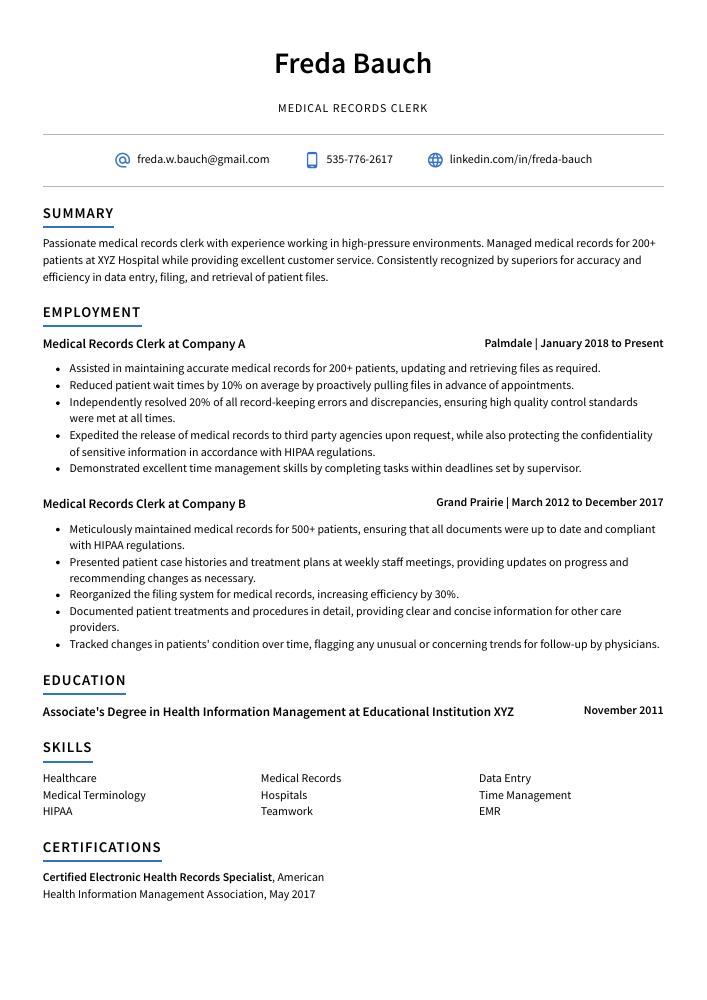Medical Records Clerk Resume Guide
Medical records clerks work in hospitals and medical offices, where they organize and manage patients’ medical records. They ensure that the records are complete and accurate, and that they are accessible to doctors and other healthcare providers. Medical records clerks also prepare reports on patients’ health status, treatments, and outcomes.
You’re an expert at organizing and keeping track of medical records, but hiring managers in the healthcare industry don’t know who you are. To get their attention, you need to write a resume that highlights your experience and achievements in this field.
This guide will walk you through the entire process of creating a top-notch resume. We first show you a complete example and then break down what each resume section should look like.
Table of Contents
The guide is divided into sections for your convenience. You can read it from beginning to end or use the table of contents below to jump to a specific part.
Medical Records Clerk Resume Sample
Freda Bauch
Medical Records Clerk
[email protected]
535-776-2617
linkedin.com/in/freda-bauch
Summary
Passionate medical records clerk with experience working in high-pressure environments. Managed medical records for 200+ patients at XYZ Hospital while providing excellent customer service. Consistently recognized by superiors for accuracy and efficiency in data entry, filing, and retrieval of patient files.
Experience
Medical Records Clerk, Company ABC
Palmdale, Jan 2018 – Present
- Assisted in maintaining accurate medical records for 200+ patients, updating and retrieving files as required.
- Reduced patient wait times by 10% on average by proactively pulling files in advance of appointments.
- Independently resolved 20% of all record-keeping errors and discrepancies, ensuring high quality control standards were met at all times.
- Expedited the release of medical records to third party agencies upon request, while also protecting the confidentiality of sensitive information in accordance with HIPAA regulations.
- Demonstrated excellent time management skills by completing tasks within deadlines set by supervisor.
Medical Records Clerk, Company XYZ
Grand Prairie, Mar 2012 – Dec 2017
- Meticulously maintained medical records for 500+ patients, ensuring that all documents were up to date and compliant with HIPAA regulations.
- Presented patient case histories and treatment plans at weekly staff meetings, providing updates on progress and recommending changes as necessary.
- Reorganized the filing system for medical records, increasing efficiency by 30%.
- Documented patient treatments and procedures in detail, providing clear and concise information for other care providers.
- Tracked changes in patients’ condition over time, flagging any unusual or concerning trends for follow-up by physicians.
Skills
- Healthcare
- Medical Records
- Data Entry
- Medical Terminology
- Hospitals
- Time Management
- HIPAA
- Teamwork
- EMR
Education
Associate’s Degree in Health Information Management
Educational Institution XYZ
Nov 2011
Certifications
Certified Electronic Health Records Specialist
American Health Information Management Association
May 2017
1. Summary / Objective
Your resume summary/objective is like an elevator pitch – it should be brief but informative, and it should give the employer a taste of your skills and experience.
In your summary, you could mention your experience working with medical records, the software programs you are proficient in using, and how you helped streamline the record-keeping process at your previous job.
Below are some resume summary examples:
Determined medical records clerk with 4+ years of experience organizing and maintaining medical records for large hospitals. Proven ability to work well under pressure in fast-paced environments. In previous roles, increased patient satisfaction scores by 22% due to prompt resolution of inquiries. Seeking to leverage organizational skills to streamline operations at ABC hospital.
Amicable medical records clerk with experience working in both hospital and clinic settings. Key strengths include data entry accuracy, filing/retrieval efficiency, and excellent interpersonal skills when interfacing with patients. At ABC Hospital, managed medical records for an average daily patient load of 200 while also providing secretarial support to the on-staff physician. XYZ Clinic commended me for increasing provider productivity by 10% through optimized scheduling and appointment reminders.
Seasoned medical records clerk with more than six years of experience working in fast-paced medical environments. Key strengths include maintaining confidentiality, entering and retrieving data accurately, and providing excellent customer service. In previous roles, decreased turnaround time for patient request fulfillment by 27% and boosted staff satisfaction ratings by 21%.
Accomplished medical records clerk with 6+ years of experience in a variety of healthcare settings. Seeking to leverage my experience and knowledge to improve patient care at XYZ hospital. At ABC, received “Employee of the Month” 3 times for excellent performance. Maintained up-to-date medical records for 500+ patients while providing support to 20+ doctors and nurses.
Dependable medical records clerk with 4+ years of experience in a hospital setting. Skilled in organizing and maintaining patient medical files, verifying insurance benefits, and scheduling appointments. Seeking to leverage multitasking abilities to support the smooth operation of the ABC medical clinic.
Hard-working medical records clerk with 4+ years of experience in a fast-paced medical office. Seeking to leverage organizational and multitasking skills to grow with XYZ. At ABC, maintained 100% accurate patient records while greeting up to 30 patients per day. Consistently recognized by management for being pleasant and helpful with patients.
Proficient medical records clerk with 10+ years experience in a variety of clinical settings. Proven ability to review, compile, and maintain patient medical records while adhering to strict confidentiality guidelines. Key achievement: Implemented an electronic medical records system that increased efficiency by 35%. Seeking a challenging position where I can utilize my experience and skills to benefit the patients and staff at ABC Hospital.
Driven medical records clerk with 8+ years of experience working in a hospital setting. Proven ability to handle confidential patient information and maintain accurate medical records. Seeking to leverage extensive knowledge of ICD-9/10, CPT, and HCPCS coding systems to streamline operations at XYZ Hospital. At ABC, increased efficiency by redesigning the filing system for incoming patient charts.
Well-rounded medical records clerk with 2+ years of experience in medical settings. Proven success in organizing and managing medical records while providing excellent customer service. In previous roles, increased patient satisfaction scores by an average of 4%. Currently seeking a challenging role at ABC hospital to leverage my skills and abilities.
2. Experience / Employment
For the experience section, you will want to provide details on your employment history. This should be written in reverse chronological order, which means that your most recent job is listed first.
When describing what you did, stick primarily to bullet points. This makes it easier for the reader to take in the information you are providing. When writing the bullet point descriptions, make sure to go into detail about what you did and the results that were achieved.
For example, instead of saying “Filed patient medical records,” you could say, “Created a filing system for patient medical records that resulted in a 50% reduction in retrieval time.”
To write effective bullet points, begin with a strong verb or adverb. Industry specific verbs to use are:
- Maintained
- Entered
- Verified
- Retrieved
- Processed
- Coordinated
- Scheduled
- Followed
- Tracked
- Monitored
- Assisted
- Investigated
- Resolved
- Communicated
- Documented
Other general verbs you can use are:
- Achieved
- Advised
- Assessed
- Compiled
- Demonstrated
- Developed
- Expedited
- Facilitated
- Formulated
- Improved
- Introduced
- Mentored
- Optimized
- Participated
- Prepared
- Presented
- Reduced
- Reorganized
- Represented
- Revised
- Spearheaded
- Streamlined
- Structured
- Utilized
Below are some example bullet points:
- Improved data organization by developing a new filing system that decreased retrieval time by 30%.
- Scheduled and oversaw the transition of patient medical records to electronic health record keeping, ensuring no data was lost in the process.
- Revised outdated policies and procedures for handling patient medical records, increasing compliance with HIPAA regulations by 15%.
- Structured and led training sessions for new staff on proper medical records management techniques, decreasing onboarding time by 2 weeks.
- Successfully converted 10 years worth of paper medical records into digital format, freeing up valuable storage space in the process.
- Optimized medical records management process, resulting in a 15% decrease in processing time.
- Processed an average of 500 medical records per day and maintained 100% accuracy.
- Spearheaded the digitization of paper medical records, reducing storage costs by $1,000 per month.
- Facilitated the release of patient information to authorized parties in a timely manner, ensuring compliance with HIPAA regulations.
- Actively participated in meetings with department heads to discuss updates and improvements to medical records management process.
- Diligently maintained and updated medical records for 500+ patients, ensuring that all information was accurate and up to date.
- Streamlined the retrieval process for medical records by implementing a new filing system; this reduced retrieval time by 30%.
- Mentored 2 new medical records clerks on proper record-keeping procedures and techniques.
- Retrieved patient files in response to requests from doctors, nurses, insurance companies and lawyers; provided copies of records as requested while maintaining confidentiality of patient information.
- Monitored incoming data for accuracy and completeness before entering it into the medical record database; this prevented errors in patient data entry by 98%.
- Competently maintained and updated patient medical records, ensuring accuracy and compliance with all relevant regulations.
- Utilized a variety of software applications to input, store and retrieve patient data; achieved 99% data entry accuracy rate.
- Achieved significant reductions in filing times by implementing a new organization system for paper medical records; cut average per-file processing time from 15 minutes to 5 minutes.
- Assessed patients’ needs and directed them to the appropriate care provider based on their individual situation; coordinated follow-up appointments as needed.
- Demonstrated excellent customer service skills when interacting with patients, families and other members of the healthcare team; consistently received positive feedback from patients regarding recordkeeping services provided.
- Advised patients on medical records retrieval process and status of their requests.
- Verified accuracy of patient information in medical files and updated records as needed.
- Developed efficient filing system for new patient intake forms and documents.
- Resourcefully located missing charts and completed paperwork using hospital database tools.
- Followed up with patients post-discharge to ensure all required documentation was received.
- Entered patient medical information and vital signs into electronic health records system, ensuring accuracy and completeness of data.
- Communicated with patients, physicians and other health care professionals to obtain missing or incomplete medical information.
- Represented the organization in a professional manner at all times, providing exceptional customer service to patients, families and visitors.
- Participated in quality improvement initiatives to help ensure compliance with organizational policies and procedures.
- Reliably performed all duties in a timely and efficient manner, meeting or exceeding expectations for productivity and accuracy levels.
- Prepared and processed medical claims for over 500 patients, ensuring that all required information was accurately included and submitted in a timely manner.
- Formulated new patient files and archived existing ones according to strict confidentiality guidelines; updated and maintained records on a daily basis.
- Effectively communicated with insurance companies regarding claim status and coverage details; compiled data and prepared reports per request.
- Compiled patient histories, test results, diagnoses & treatments into comprehensive medical records; assisted doctors with retrieving important information during consultations.
- Maintained up-to-date knowledge of HIPAA regulations to ensure compliance when handling sensitive patient information; provided guidance to other staff members on proper protocol.
- Demonstrated initiative and accuracy when completing daily tasks, such as data entry of patient information into the electronic medical records system, scanning and filing of documents, and retrieval of records for clinicians.
- Accurately maintained medical records in accordance with established policies and procedures; investigated and resolved discrepancies in a timely manner.
- Introduced a new system for tracking patient appointments and follow-up visits, which resulted in a 15% decrease in missed appointments.
- Demonstrated excellent customer service skills when interacting with patients, families, visitors and other members of the healthcare team.
3. Skills
Job skills will differ from employer to employer but, typically, a medical records clerk will be expected to have strong organizational skills, computer literacy (including experience with medical software), and excellent communication abilities.
It is essential that your resume highlights these skills as many employers use applicant tracking systems (computer programs that scan resumes for specific keywords) when reviewing job applications. If your resume doesn’t include the right keywords, it is unlikely to make it through the initial screening process.
In addition to just listing skills in this section of your resume, you should also highlight them in other areas – such as the summary or experience section – so that they are not lost amongst all the other information included on your document.
Below is a list of common skills & terms:
- CPR Certified
- Customer Satisfaction
- Data Entry
- EHR
- EMR
- Electronic Medical Record
- Filing
- HIPAA
- Healthcare
- Healthcare Information Technology
- Healthcare Management
- Hospitals
- Medical Billing
- Medical Coding
- Medical Records
- Medical Terminology
- Patient Safety
- Teamwork
- Time Management
4. Education
Including an education section on your resume will depend on how far along you are in your career. If you just graduated and have no work experience, mention your education below your resume objective. However, if you have worked as a medical records clerk for years with plenty of responsibilities to showcase, omitting the education section is perfectly fine.
If an education section is included, mention courses, subjects and coursework related to the medical records clerk job you are applying for. Examples include “Courses studied included: Health Information Management & Technology, Medical Terminology” and “For my final year project, assisted in migrating patient files from paper to electronic format.”
Associate’s Degree in Health Information Management
Educational Institution XYZ
Nov 2011
5. Certifications
Certifications are a great way to show a potential employer that you have the skills and knowledge required for the job. They also demonstrate that you are committed to keeping your skills up-to-date.
If you have any relevant certifications, include them in this section of your resume.
Certified Electronic Health Records Specialist
American Health Information Management Association
May 2017
6. Contact Info
Your name should be the first thing a reader sees when viewing your resume, so ensure its positioning is prominent. Your phone number should be written in the most commonly used format in your country/city/state, and your email address should be professional.
You can also choose to include a link to your LinkedIn profile, personal website, or other online platforms relevant to your industry.
Finally, name your resume file appropriately to help hiring managers; for Freda Bauch, this would be Freda-Bauch-resume.pdf or Freda-Bauch-resume.docx.
7. Cover Letter
A cover letter is a document that you send along with your resume when applying for jobs. It’s an opportunity to introduce yourself and explain why you’re the best candidate for the role.
Cover letters are usually not required, but they can give you a chance to stand out from other candidates. If you choose to write one, make sure it’s brief (2-4 paragraphs) and includes information that isn’t already in your resume.
Below is an example cover letter:
Dear Larue,
I am writing to apply for the position of Medical Records Clerk at your hospital. With experience working in both paper and electronic medical records systems, I am confident that I can be an asset to your team.
In my current role as a Medical Records Clerk at [hospital name], I maintain both paper and electronic patient records. I have experience scanning documents into the electronic system, updating patient information, and ensuring that all records are accurate and up-to-date. In addition, I regularly pull charts for doctors and nurses upon request and file discharged patients’ charts.
The skills that I have developed in my previous roles will contribute to my success in this position. My attention to detail ensures accuracy in patient records, while my excellent organizational skills keep the medical records room tidy and organized. In addition, my interpersonal skills enable me to effectively communicate with doctors, nurses, patients, and their families.
I would welcome the opportunity to bring my experience and skill set to your hospital as a Medical Records Clerk on your team. Thank you for your time; I look forward to speaking with you soon about this opportunity.
Sincerely,
[Your name]
Medical Records Clerk Resume Templates
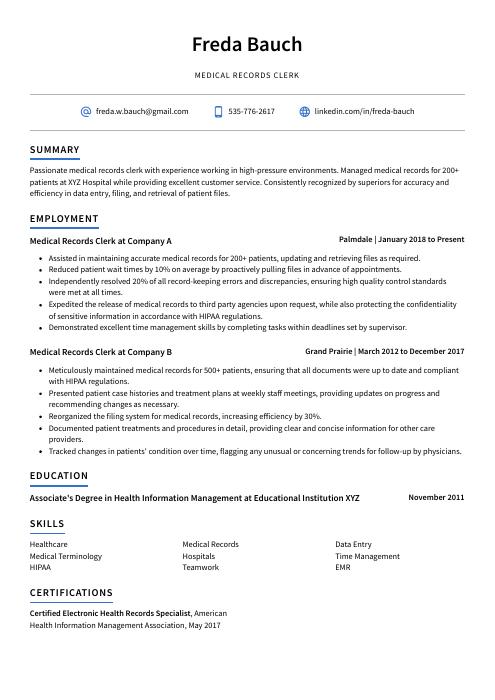 Axolotl
Axolotl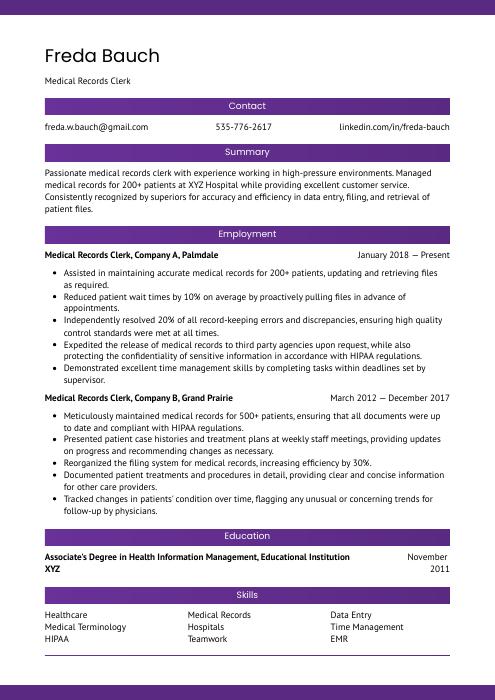 Jerboa
Jerboa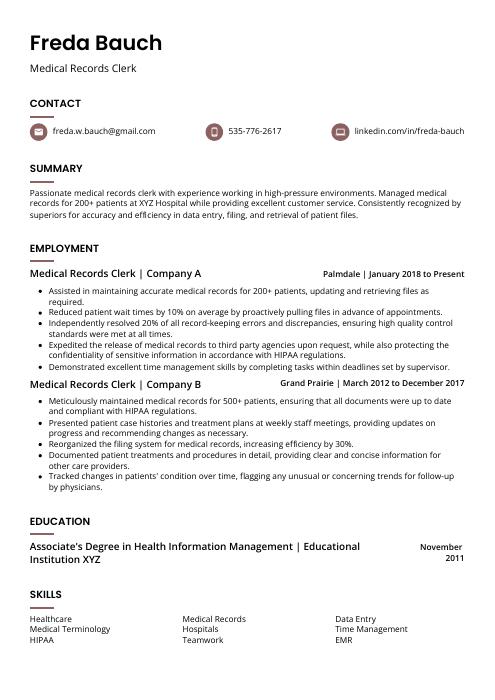 Fossa
Fossa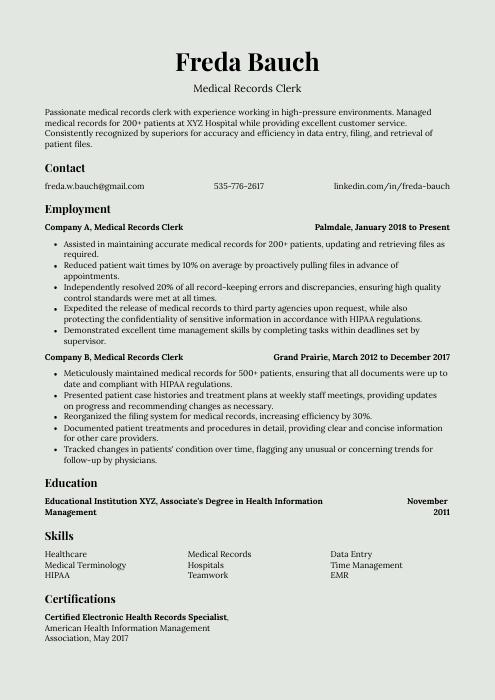 Saola
Saola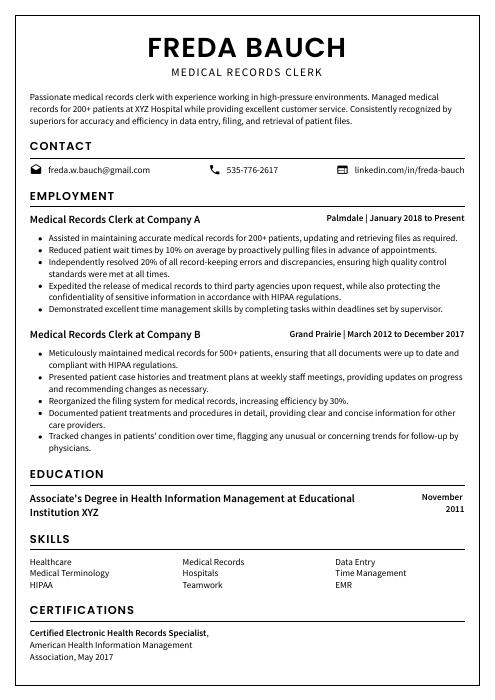 Cormorant
Cormorant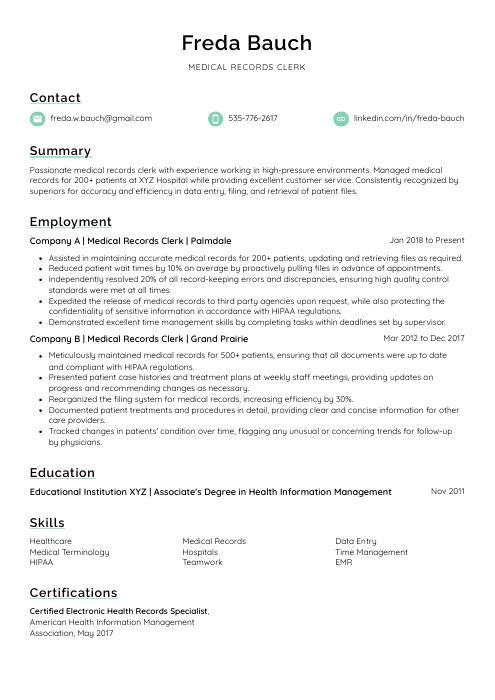 Lorikeet
Lorikeet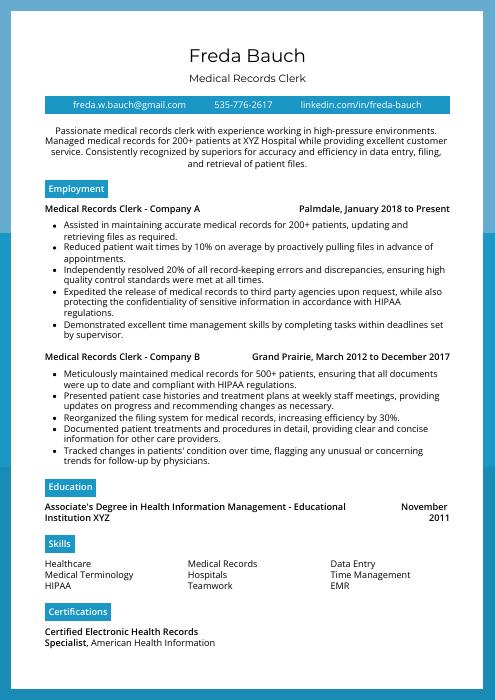 Rhea
Rhea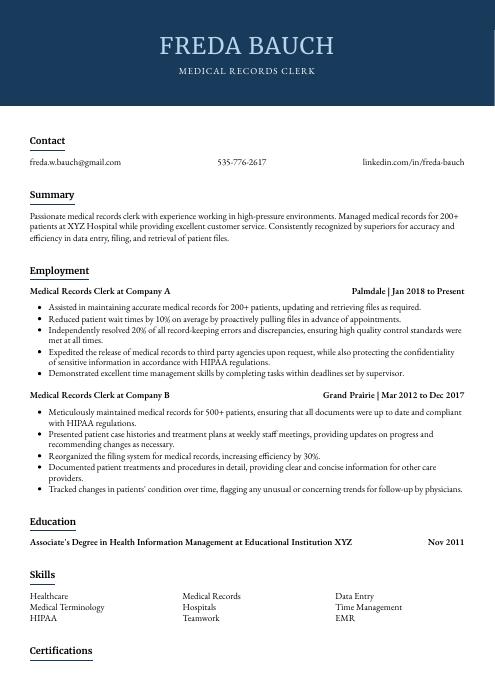 Bonobo
Bonobo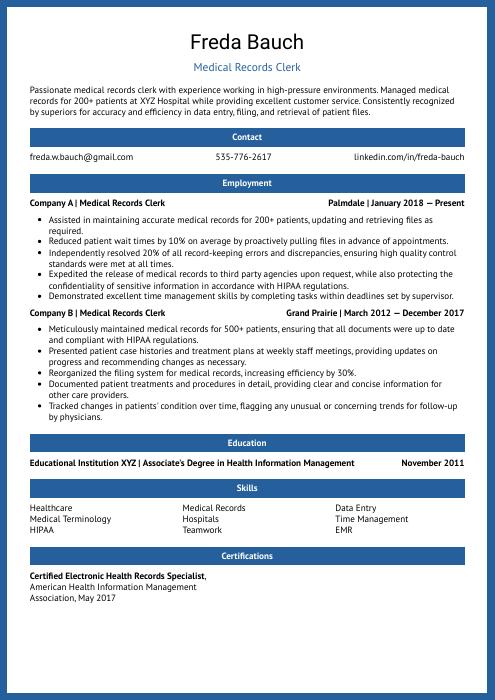 Ocelot
Ocelot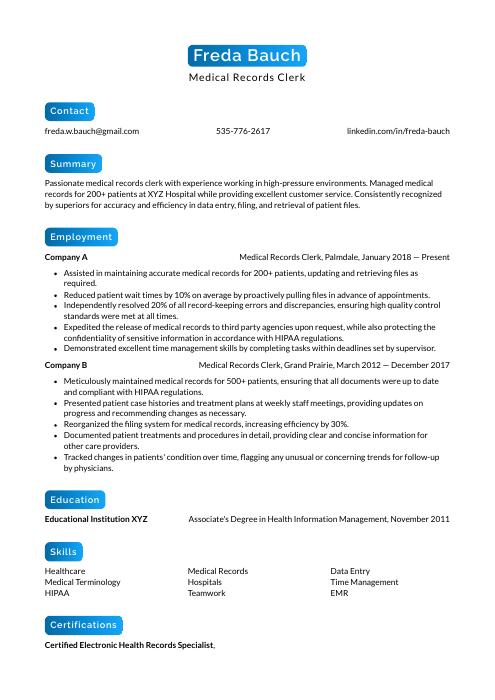 Kinkajou
Kinkajou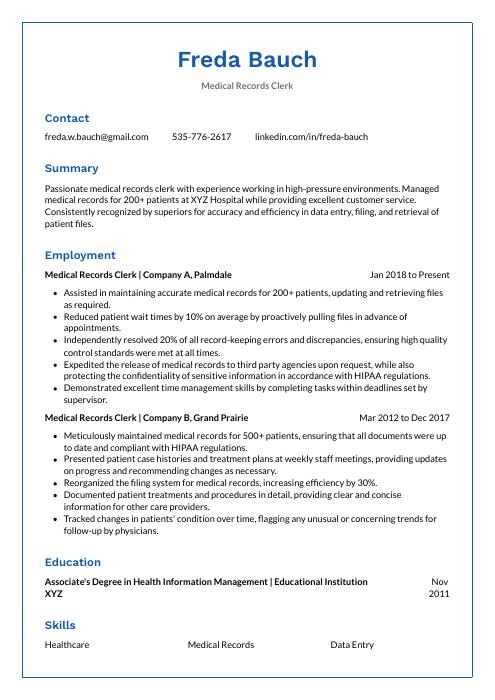 Markhor
Markhor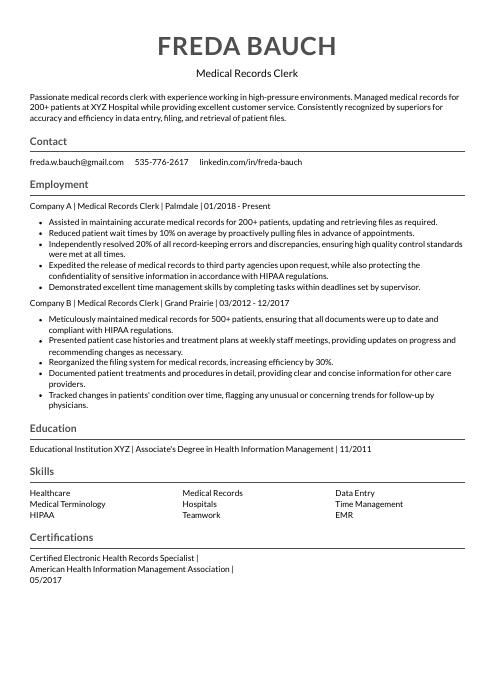 Indri
Indri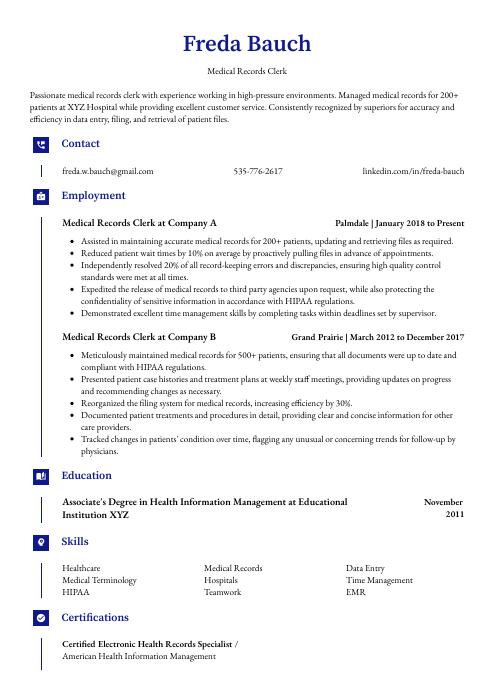 Gharial
Gharial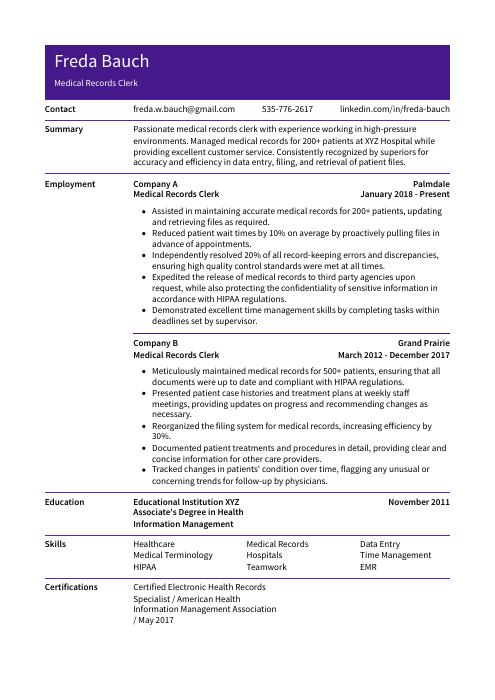 Pika
Pika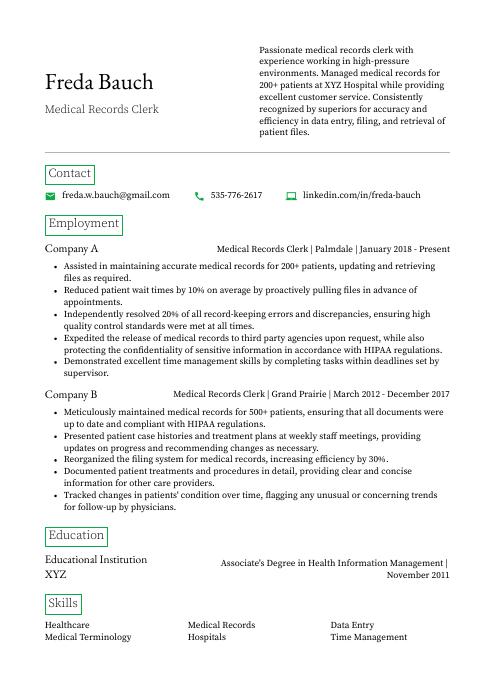 Quokka
Quokka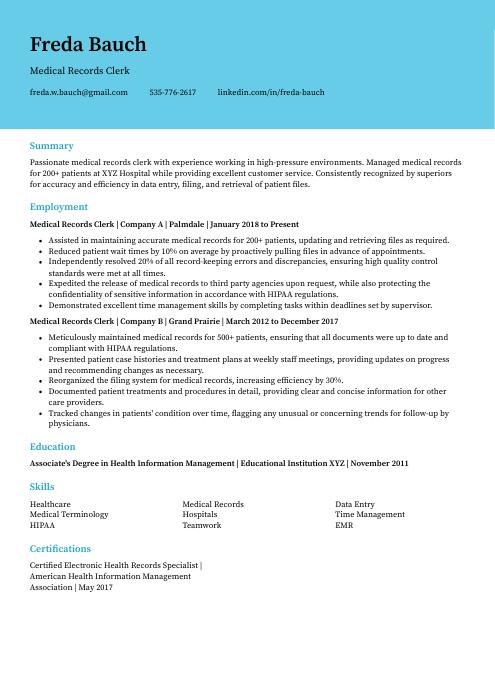 Dugong
Dugong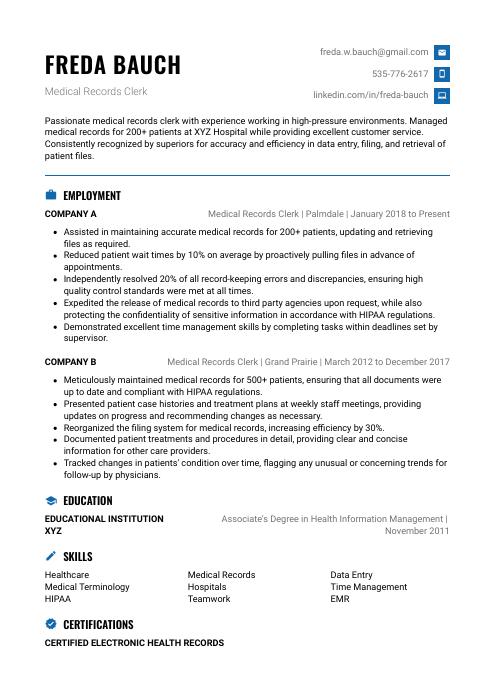 Echidna
Echidna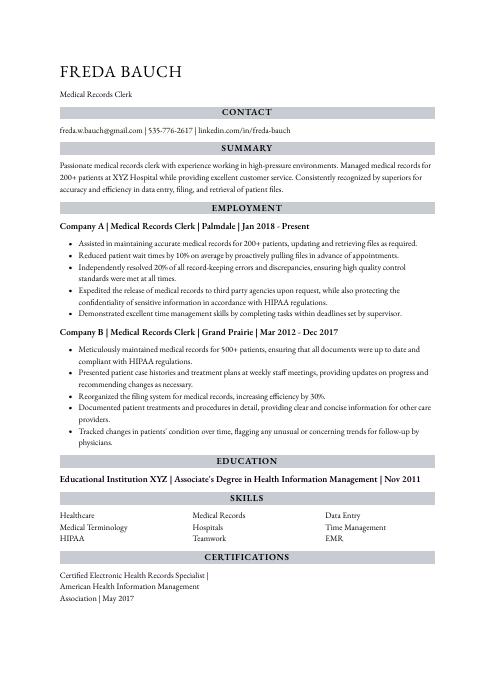 Numbat
Numbat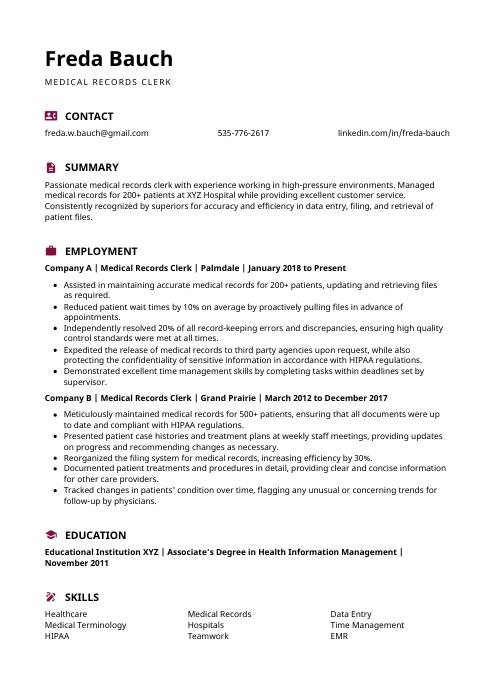 Hoopoe
Hoopoe Rezjumei
Rezjumei
